“Starship Down”
Written by David Mack & John J. Ordover
Directed by Alexander Singer
Season 4, Episode 6
Production episode 40514-479
Original air date: November 13, 1995
Stardate: 49263.5
Station log: The Defiant is meeting with the Karemma in the Gamma Quadrant to discuss problems with the trade agreements made between the Federation and the Karemma—which are quickly revealed in a meeting among Sisko, Quark, and the Karemma representative Hanok to be all due to fees and taxes and tariffs levied by the Ferengi, who are serving as intermediaries.
On the bridge, Worf is cranky about slow response times in weapons drills, and Kira expresses disappointment to Dax that they’re missing Ha’mara, the anniversary of the Emissary’s arrival. Kira suspects that Sisko scheduled the negotiations so he could avoid the festival, since he’s still uncomfortable with his role as Emissary.
Two Jem’Hadar ships approach. Worf puts the ship on red alert and summons Sisko to the bridge, leaving Quark in the mess hall. The Jem’Hadar are after the Karemma, punishing them for defying the Dominion and meeting with the Federation. The Karemma ship tries to lose the Jem’Hadar in the atmosphere of a gas giant, and Sisko takes the Defiant in after them.
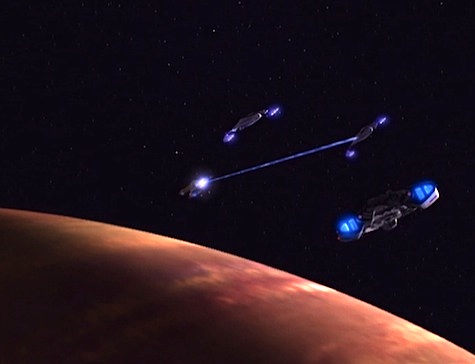
Kira has an echo-location trick from the resistance that she and Dax make use of to expand their sensor range to try to find the Karemma and the Jem’Hadar. They find the Karemma that way—but then the Jem’Hadar show up and fire on the Defiant. They’ve lost impulse power and weapons. The ship is plummeting into the atmosphere. A hull breach means a deck needs to be evacuated—the force fields can’t hold up for long under the atmospheric pressure—and everyone gets out except for Bashir and Dax, who barely make it to a turbolift shaft.
Dax was down there effecting repairs, which worked, giving the ship impulse power back, and O’Brien and his people have modified a couple of atmospheric probes to become torpedoes. They find one Jem’Hadar ship via Kira’s echo-location method, and go to a full stop with all nonessential systems shut down. They fire the modified probe, programmed to hit the first metallic thing it encounters. It works, but not before the Jem’Hadar fires repeatedly on the Defiant. Sisko is badly injured and barely conscious, two other crew members are dead, and all power to the bridge is out. Kira and Ensign Carson treat Sisko, but he has a concussion. Kira stays on the bridge to keep Sisko awake and conscious, since lapsing into unconsciousness would be disastrous. Carson tries to find a medic, while Worf goes to engineering to try to take control of the ship from there.
Hanok is pissed off at Quark for cheating him, and Quark’s attempts to mollify him all fail. The problem is that the Karemma believe that merchandise has a set value based on the cost of the raw materials, the labor involved in creating it, transportation, and a reasonable markup, and that’s how they set their price. There’s no room for greed, which Quark finds disappointing. The Karemma way is just barter—there’s no gambling involved, no risk, but the Karemma don’t believe in gambling.
Bashir and Dax are trapped—their combadges can’t penetrate the atmospheric interference, and there’s no way out. It gets colder and colder, and they have to cuddle, which is just awful for them…
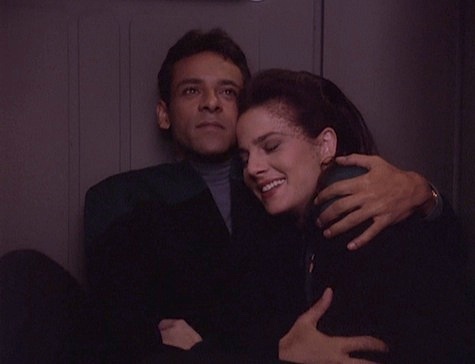
Kira’s attempts to keep Sisko awake are awkward and difficult—mainly because they only talk about work, and that’s all she can think of to discuss with him. Sisko groggily asks her to tell him a story, and she tells him about the three brothers who go to Jo’Kala. Before she can finish the story, she gets frustrated, scared Bajor will lose the Emissary. Against her better judgment, she gives him a stimulant and prays for him, even if it makes him uncomfortable. Sisko interrupts the prayer to ask what happened to the three brothers. After she finishes the story, he asks her to tell him another one.
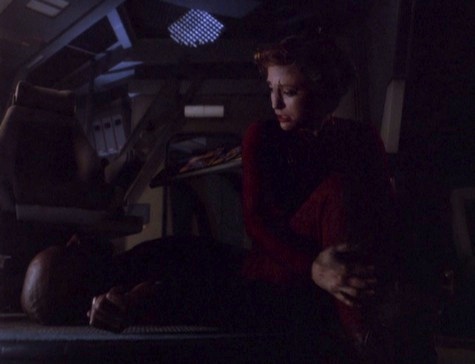
Worf takes over engineering, snapping at Muniz and Stevens, two of O’Brien’s engineers (at one point, O’Brien has to remind Worf not to be such an asshole when dealing with enlisted engineers). They detect two torpedoes and avoid one, but the second strikes the ship, penetrating the hull to the mess hall—but it doesn’t detonate. Against Hanok’s better judgment, he and Quark try to defuse the defective torpedo before it decides to go ahead and explode. Quark manages to get the casing off, and then Hanok admits that it’s a torpedo the Karemma sold to the Jem’Hadar. Quark makes a snide comment about how he thought the Karemma never sold substandard merchandise. Unfortunately, Hanok isn’t sure which of the two diodes they need to remove—one will defuse it, the other will detonate it. Quark reaches for one, and of course it’s the right one because he’s the opening-credits regular on a TV show. Hanok is enthused at the emotional turmoil of the risk, and starts to come around to Quark’s POV on risk-reward excitement.
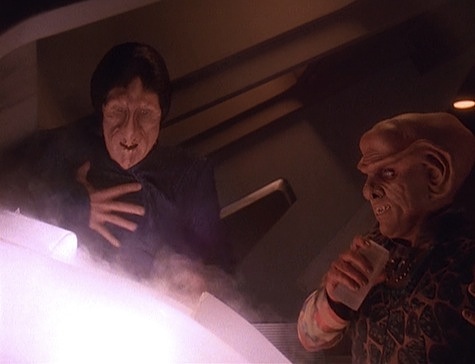
Taking O’Brien’s advice, Worf gives Stevens and Muniz a problem to solve: give him a weapon that will fire once. They hit on routing the phasers through the deflector array. O’Brien uses the echo-location to find the other Jem’Hadar ship, and then Worf orders Stevens to fire on them. The Jem’Hadar are destroyed, and then they find the Karemma ship in the atmosphere. Bashir and Dax are rescued, Muniz goes to deal with the torpedo only to find Quark and Hanok renegotiating their deal, and Sisko is treated.
Everyone makes it back safely to Deep Space 9. Hanok takes a spin at the dabo wheel—and wins, to Quark’s dismay and Odo’s great amusement—while Dax rescues Bashir from the world’s most boring conversation with Morn, thus making them even. Meanwhile, Sisko invites Kira to accompany him to a baseball game, which Kira happily accepts.
Can’t we just reverse the polarity? Dax needs to repair an ODN conduit in order to get impulse power back, and O’Brien, Muniz, and Stevens get to do all kinds of entertaining rerouting and reorganizing and stuff.
The Sisko is of Bajor: Sisko is barely conscious for most of the episode, but he hears Kira babbling on about four-shift rotations enough to suggest that they look into it at episode’s end. He also invites Kira to a baseball game, the truest sign of friendship with Sisko.
Don’t ask my opinion next time: Kira is frustrated by her continued inability to talk to Sisko about anything but work because she has a hard time reconciling her colleague and commanding officer Benjamin Sisko with the Emissary of the Prophets. But she manages it in the end…
She also uses an old resistance trick to help find other ships in the gas giant, using a trick they developed when hiding in the Badlands.
The slug in your belly: Dax fixes an ODN conduit, which saves the day, and her reward is to be stuck in a turboshaft with Bashir.
There is no honor in being pummeled: Between this and “Rejoined,” it appears that Worf is in charge of the day-to-day of the Defiant, and second in command to Sisko. As time goes on, this will become clearer, but it appears to be set up that Worf is the SIC on the Defiant, while Kira is SIC on the station. This makes sense, as DS9 is a Bajoran station and the Defiant is a Starfleet ship, although that doesn’t explain why Kira’s on this mission…
Worf gets to be in charge, and get some advice from his senior noncom on how to deal with the enlisted folk. Proving he’s not an idiot, he listens to O’Brien’s advice.
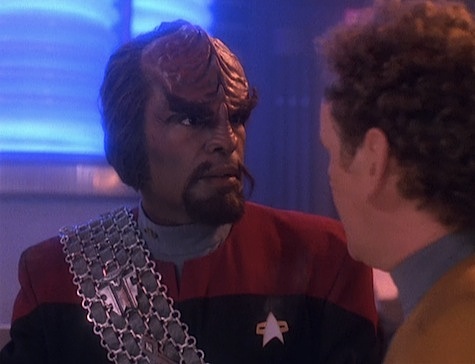
Rules of Acquisition: Quark admits that dealing with the Federation, who are apparently ridiculously easy to cheat, has made him lazy and so he gets caught by the Karemma. But he also introduces Hanok to the joys of gambling.
Victory is life: Following the events of “The Search, Part I,” the Karemma and the Federation have been trading partners, using the Ferengi as intermediaries. However, the Dominion doesn’t like this idea at all, and send two Jem’Hadar ships for the express purpose of taking it out on the Karemma.
Tough little ship: The Defiant gets its ass kicked, but it also kicks lots of ass, and wins in the end, though they only manage it with modified weapons, as the Jem’Hadar take out their primary weapons in their second attack.
No sex, please, we’re Starfleet: Bashir admits that being stuck in a turbolift alone with Dax is very much like a fantasy he had in his early days on the station. Dax is disappointed that he doesn’t have that fantasy anymore, making Bashir decide that she liked his chasing her. That’s a generous interpretation, though Dax doesn’t deny it, and Bashir says he doesn’t have to chase her since he knows she liked it, so he doesn’t have to anymore. It’s tortured logic, but at least it means we don’t have to keep watching him make an ass of himself…
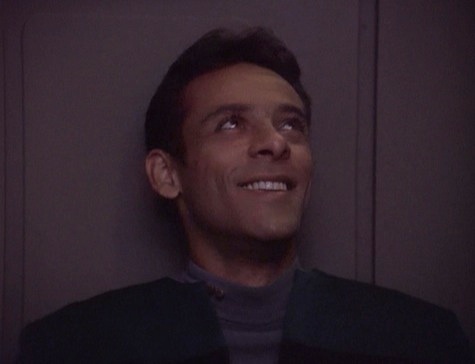
Keep your ears open: “The captain’s gotten us out of tougher spots than this. Last year, when the Romulans tried to invade the Founders’ homeworld, we went up against a dozen Jem’Hadar ships.”
“I know, Chief. You’ve told me the story.”
“Yeah? Well unless you want to hear it again, you’d better get down to the torpedo bay and start working on those probes!”
O’Brien motivating Stevens by telling him about “The Die is Cast.”
Welcome aboard: James Cromwell, who played Nayrok in TNG’s “The Hunted” and Shrek in the TNG two-parter “Birthright,” and who will go on to play Zefram Cochrane in First Contact and a couple of Enterprise episodes, plays Hanok. F.J. Rio, Jay Baker, and Sara Mornell play, respectively, Muniz, Stevens, and Carson. Rio will return as Muniz in “Hard Time” and “The Ship,” and he’ll appear as other characters in Voyager’s “Repentance” and Enterprise’s “Cogenitor.”
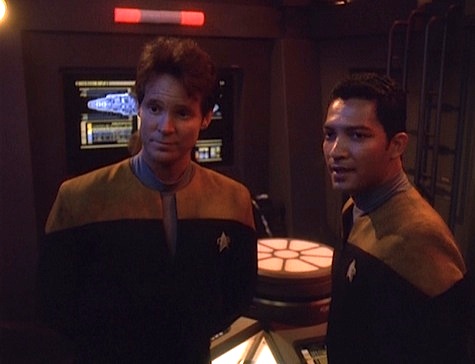
Trivial matters: This episode is one that I have a particular interest in, because the two people in the writer credit, David Mack and John J. Ordover, are numbered among my closest friends. For that reason, I was in on much of the writing of this episode, including an informal table read among a bunch of us of the script before they submitted it. Mack and Ordover’s original notion was that of a submarine-style story—indeed, they originally pitched it as being underwater, later changed to a gas giant. Mack’s original notion was to sink the Defiant, inspired by having watched Das Boot the night before.
At the time the episode was written, Mack was an aspiring screenwriter, and Ordover was the Senior Editor at Simon & Schuster in charge of the Star Trek novels. Ordover’s job gave him the in to pitch, and Mack had the creative spark for a lot of their stories, and they wound up collaborating on several scripts and comic books for many years, including a Voyager script that was purchased but never produced, the story for the DS9 episode “It’s Only a Paper Moon,” and the TNG/DS9 crossover comic book Divided We Fall.
The script received an uncredited page-one rewrite, which I mostly know because I was part of that aforementioned table read, and know that very little of Mack and Ordover’s script made it to the final episode. However, they received sole credit.
Ordover was responsible for a lot of innovation in the Trek novel line in his tenure, responsible for the first interseries crossovers (starting in 1996 with Invasion!), the first novels not based on one of the TV series (starting in 1997 with New Frontier). He remained at S&S until 2003 before moving on to Phobos Books; these days he’s the owner of the SoHo Art House, a space in New York City where your humble rewatcher had the launch for his short story collection Ragnarok and Roll, and which hosts the monthly New York Review of Science Fiction Readings, AniMiniCon, BaconPalooza, and many other cool events.
Mack moved over to the prose side of things, and has become one of the most prolific authors of Trek fiction in recent years, including the landmark Destiny trilogy and the New York Times best-selling Cold Equations trilogy. He collaborated with your humble rewatcher on the Starfleet Corps of Engineers story Invincible, and his SCE story Wildfire was similarly themed to “Starship Down,” in that the da Vinci had to go into the atmosphere of a gas giant, though the da Vinci took considerably more damage (and suffered more casualties) than the Defiant. Mack also co-created the original-series-era novel series Vanguard and Seekers.
While Stevens never appears again on screen, he became a regular in the aforementioned SCE series, given the first name of Fabian, and working as a structural systems engineer on the da Vinci. He also appeared in your humble rewatcher’s A Singular Destiny. (In the flashback to his arrival on the da Vinci in your humble rewatcher’s War Stories, he and Duffy—from TNG’s “Hollow Pursuits”—compare Chief O’Brien stories.)
Hanok is mentioned as being elected to the position of chief overseer for the Commercial Authority on Karemma in your humble rewatcher’s Q & A.
Ferengi trade with the Gamma Quadrant started in “Rules of Acquisition,” and have apparently continued apace since.
Kira’s four-shift rotation suggestion will be implemented in “Accession.”
The cap that Sisko gives Kira to wear for their baseball game belongs to the Homestead Grays, the Negro Leagues team that Josh Gibson and Cool Papa Bell, among others, played for. Sisko’s cap is the Pike City Pioneers cap that Kasidy Yates gave him in “The Way of the Warrior.”
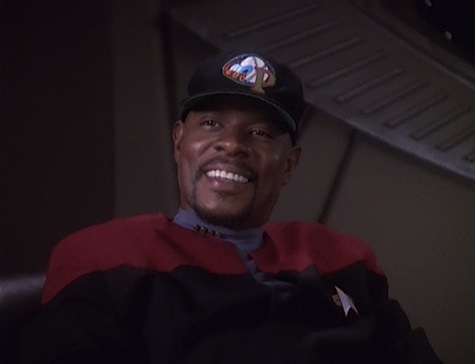
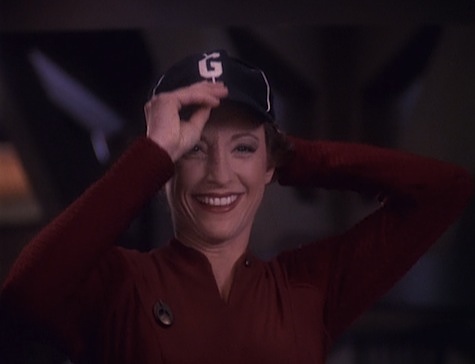
The holiday of Ha’mara will be retroactively established in the eponymous short story in Prophecy and Change by Kevin G. Summers, which takes place right after “Emissary,” and has Kai Opaka officially declaring Sisko to be the Emissary.
Walk with the Prophets: “I hate the Gamma Quadrant.” This is a fun little episode, and I’m not just saying that because two friends of mine wrote it. If anything, I was hoping for better from the two of them. (And oh man, am I gonna hear it from them for that sentence…)
But it’s a very enjoyable action piece with suspense and thrills and character development. It’s very much like “Civil Defense” and TNG’s “Disaster” in that the crew is divvied up into different areas during a crisis. Just as the other two episodes had their weak spots (Quark and Odo, and La Forge and Crusher, respectively), this one has the limp Bashir-Dax pairing, which falls completely flat (and is also kind of creepy, trying to retroactively make Bashir’s near-stalking of Dax in season one into something she enjoyed; yuck).
The rest works just fine. Kira confronting the six-hundred-pound elephant of Sisko’s status as a major figure in her religion needed to be dealt with, and I like the way it played out, both with her storytelling at his urging and his invite to baseball at the end.
It’s good to see Worf learn more about command. He’s been a CO of a staff before, but those were security guards, and you figure his drill-sergeant style would work just fine there, but, as O’Brien said, engineers are different.
And the Quark-Hanok interaction is superb, two excellent actors playing nicely off each other. I like the contrast between the Karemma’s scientific, safe capitalism versus the Ferengi’s uncontrolled greed.
Still, the episode has its problems, beyond the Bashir-Dax stuff. Sisko’s “they may be closer than you think” to Kira makes absolutely no sense, and has had me scratching my head for decades now. Worf’s ordering of Stevens and Muniz to give him a weapon seems like a nice way to get them to do something and him to take O’Brien’s advice, but he says the modified probe is “unavailable”—why? The actual plan that he implements could just as easily have been done by the modified probe. It never makes any sense.
Still, as I said, it’s a fun little episode.
Warp factor rating: 6
Author’s note: Your humble rewatcher is running a Kickstarter for a new story in the Dragon Precinct universe, featuring the characters of Gan Brightblade and his friends from that novel. He hopes you’ll support it—just two bucks will get you a copy of the story itself! The project is funded, but that just means you’re guaranteed a story if you support it, plus there are stretch goals, the first of which is cookies! Details can be found here.
Keith R.A. DeCandido will be at Farpoint 2014 this weekend, both as an author and as a musician (his band Boogie Knights will perform Saturday at noon). Other guests include this episode’s co-writer David Mack, as well as actors Melissa McBride and Phil LaMarr, Star Trek authors Alan Dean Foster, Peter David, Michael Jan Friedman, Dave Galanter, Allyn Gibson, Robert Greenberger, Glenn Hauman, Robert T. Jeschonek, Aaron Rosenberg, and Howard Weinstein, Klingon linguist Marc Okrand, and bunches more. The convention will be held at the North Baltimore Plaza Hotel in Timonium, Maryland. Here’s Keith’s schedule.










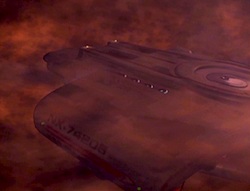
The Kira/Sisko subplot remains my favorite part of this episode. Their interactions are a nice continuation/evolution of that discussion from “Destiny” the previous year.
Kira’s my favorite DS9 main character after Odo and her development over the course of the 7 seasons was a thing of beauty (so much so that I wanted to kill the Vedek Assembly after S.D. Perry’s Avatar duology came out).
Looks like I have a new place to visit, next time I’m in NYC.
I knew the original pitch was about sinking the Defiant. In a way, I’m glad they made the change. It doesn’t sound scientifically plausible, especially given Abrams’s very own questionable execution of the same concept during the opening act of Star Trek Into Darkness. Cool idea on paper that raises questions the minute you shoot it live-action, especially on the science-oriented Trek universe.
I, for one, am glad Ira Behr is an executive producer that delivers writing credits with this much generosity. While I’m all for shared writing credits when multiple writers (and rewrites) are involved, freelancers do deserve credit for their work. Mack and Ordover deserve full credit, even if it barely resembles the original pitch. If it weren’t for that pitch, we wouldn’t even have this episode.
It’s sad that Enterprise moved away from buying outside story ideas for their episodes. Even Voyager and DS9 gradually moved away from that tendency over time. I assume they kept this tradition as long as they did because Michael Piller’s the one who started it back in 89.
Yeah, the Kira-Sisko stuff is the highlight of the episode. I also like seeing the engineering crew fleshed out; DS9 paid far too little attention to junior officers, sticking people like Kira and Odo and Bashir and Garak and even Cadet Nog into positions that there should’ve been dozens of more qualified junior officers on hand to fill.
I had a problem with the physics of the hull-breach sequence. The reported pressure on the hull was enormous, like 9 million grams per square centimeter and rising, which is close to 9000 atmospheres. So if the Jovian’s atmosphere breached the ship at those pressures, it wouldn’t have just been a cloud of choking gas that the characters could run from — the pressure would’ve instantly crushed anyone in the flooded compartments. But then, this is a perennial failing of submarine movies as well, a failure to understand the effects of extreme pressures. They’ll frequently talk about the enormous pressure outside crushing the hull, but then just have water leak in under normal pressure or with just the force of a garden hose, when in reality a jet of water at that pressure could carve through bone or steel. When this sort of thing happens in Trek, I usually try to rationalize it by pretending that the shields are blocking most of the pressure and only letting a little bit through.
As far as Worf and the Probe go, I remember when they came up behind that Jem ‘Hadar ship and fired the beam from the Deflector Dish, just before that, the Jem ‘Hadar ship stopped in front of an object. I thought that object was the probe and part of Worf’s plan was to have it sit there as a decoy so the Jem ‘Hadar would be distracted long enough for the Defiant to come up behind them and blow them up.
My big question is what would have happened to the Karemma really after this episode? The Jem ‘Hadar sent two ships after them and were destroyed, but if those ships came after the Karemma, doesn’t that mean the Dominion knew about this? There seemed to be no talk of consequences to the Karemma after destroying those two Jem ‘Hadar ships.
Submarine stories transfer to outer space very well in general (Balance of Terror, for example). The hostile and deadly environment outside the skin of the ship, the lack of visual contact. And the atmosphere of a gas giant makes a very good analog to a deep dive.
Certainly in terms of the larger story beyond this episode the stuff between Sisko and Kira is necessary and long overdue. They’ve danced around the dichotomy of Sisko as CO and Emissary before, but never really settled anything. This is a big step for her and for their relationship and will allow them to work much better together as the general situation gets a lot hairier.
The Bashir/Dax thing is less well done and, while it does clear the air a little, it wasn’t really necessary either. There is some nice body language from Siddig, though. That screenshot where he has Dax in his arms does a really good job of saying “I used to want this a lot, but this isn’t right.”
I really enjoyed the Kira/Sisko scene also. At this stage in the series, the Emissary issue was handled well, but IMO it went somewhat off the rails in seasons 6-7.
Also, Quark saves the day – kinda. Without his fees, the meeting would never have taken place and the Dominion would have wiped out the Karemma, so really they should be grateful to him.
Dax has been on the Bajoran station since Sisko was declared the Emmisary, right? So why does Kira need to explain Ha’mara to her? I mean, Dax is Sisko’s best friend and Sisko is the Jesus to this Christmas, is there something I missed?
@7: Hardly Jesus — more Moses or Muhammad. Heck, not even that, since he’s not bringing revelations from the Prophets, he’s just someone with a destined role to play in fulfilling their will. So maybe more like one of the saints.
Somehow I’ve never found the Julian/Dax scenes awkward. The only part of this episode I dislike is the brainstorming between the engineers. I’ve always thought that particular scene was extremely cheesy.
Everything else I like, especially the part where Quark says if they choose the wrong one they die. The way he says “we die!” is hilarious. It’s a great example of humor in an extreme situation which I think works far better than in the series finale when Kira, Damar, and the others can’t open the door to Dominion HQ.
@@.-@:
It’s not really established the Dominion know what the Karemma are doing. It’s possible the Jem’Hadar were on a routine patrol and detected the ships. Once they were in the gas giant they might’ve been unable to send a message back to the Dominion. If it was a routine patrol they may have thought a message was unecessary in the first place; they’re on their home turf, Federation ships hadn’t proven much of a threat to them up to this point, and the Enterprise and Defiant didn’t contact Starfleet every time they encountered something unusual so I assume the Jem’Hadar wouldn’t bother the Founders with something they consider trivial.
A nice tense action episode. I thought the Bashir-Dax stuff was necessary, and Dax not denying she enjoyed Bashir chasing her may have been her just humoring her friend, because she knows he’s over all that and not going back to that. Besides, I’m sure Julian at this point has Leeta on his mind (could you blame him? ), which Dax is also aware of. Bashir at this point is majorly different than season 1 Bashir, far more mature, and he and Jadzia are good friends. You sense Julian is quite happy with that now. So, why not humor the man and let him think she enjoyed the chase?
It was good to see Worf taking advice, because as Worf himself said in “The Way of the Warrior”, he has a lot to learn about command. This episode makes that pretty clear, but its good Worf remains open to advice. Also great to see Sisko and Kira bridge the final gap in their friendship and actually forget about work or Sisko being the Emmisary, at least for a few hours every so often.
Finally, I never got why Worf was SIC on the Defiant. I get the rationale, but Kira has been First Officer, even on the Defiant, before Worf’s arrival, so why would that change? I guess the producers eventually agreed with me *Spoiler Alert* because in “Tears of the Prophets”, after Sisko is incapacitated, Kira takes command even with.Worf on the bridge. I don’t know why that bothered me so much.
@11: It didn’t make sense for Kira to be second-in-command on the Defiant, because she wasn’t a Starfleet officer. It’s the same complaint I made above about junior officers. What DS9 should have done is established a distinct crew for the Defiant. They had such a big ensemble cast, so why couldn’t they flesh it out with more Starfleet characters to be the dedicated crew of the ship?
YOu mean like the obvious B team that Starfleet sent along on the Defiant to engage the Borg in First Contact? Normally, the entirety of the opening credit cast is on that ship…but for the Borg invasion, they just send Worf…and that guy, and that woman, and that guy. I always found that funny. But it makes sense because then the rest of the movie you would have had to explain who Kira and Sisko and Dax were and that was a TNG movie.
But still, not a bad episode. So far, the weakest of season four, but that doesn’t make it bad. Dax got to be useful, O’Brien-cool as always and Sisko got to chill a little bit in Kira’s lap. Not a bad day, other than the headache.
Matt: I actually came up with an in-universe explanation for that. In the final part of the Slings and Arrows ebook miniseries, which chronicles the year leading up to First Contact, I had Admiral Hayes (the same guy who benched Picard in FC because of his ties to the Borg) orders Sisko to stay behind because the Borg killed his wife, and they don’t want that anguish on the trigger finger of the Defiant. Hayes puts Worf in charge because of his experience, but everyone what on the ship has to have served for less than a year under Sisko — that last mindful of the events of “The Die is Cast.”
—Keith R.A. DeCandido
See I haven’t gotten to read those just yet, but if it is as interesting as your explanations about Star Trek Nemesis, then I’m sure it is good. At the same time, however, if they wanted the Borg destroyed, would it matter that Sisko was going to just obliterate them out of revenge? Or is that a case of them worrying about him endangering others in his Ahab like persuit of revenge (much like Picard in that movie)?
@15: They wanted him to be able to think clearly rather than letting rage blind him. Defeating the Borg is a great deal more easily said than done. Just screaming and shooting in their general direction won’t cut it — it takes strategy and caution.
@14, That’s always been a clever way of explaining why Worf was the only familiar Ds9 face on board the ‘escort frigate’.
It makes you wonder what would have happened if Worf hadn’t joined the cast of Ds9, thus necessitating the Defiant‘s presence in First Contact as the mechanism for reuniting him with his TNG buddies.
Would Sisko have gotten a cameo apperance instead? Or would the Defiant have even been present at all?
Has it ever been covered in the books where the Enterprise-E was during the Dominion War, aside from Insurrection?
@12, If Starfleet officer Benjamin Sisko can command a Bajoran space station, why shouldn’t the Bajoran Liason Officer be second in command of the Defiant? Seems a fair exchange, since Kira is already under Sisko’s command.
Alright Then: I don’t have the full list handy, as I’m at a convention, but several books do cover it, among them the two
“Dominion War” novels by John Vornholt, a couple of the stories in the “Tales of the Dominion War” and “The Sky’s the Limit” anthologies, and “The Battle of Betazed” by Charlotte Douglas & Susan Kearney.
—Keith R.A. DeCandido
And there are some novels and stories about the E-E that are set during the Dominion War but not focused on it, like Jeffrey Lang’s Immortal Coil and the Kevin Anderson graphic novel The Gorn Crisis.
Tales of the Dominion War was great. I’m a little obsessed with the Dominion War (both of my STO characters are heavily Domionion War based, not that that counts for much lol) but I haven’t gotten to The Sky’s the Limit yet.
@22, Yeah, I hear you.
The Dominion War is easily among my favorite myth arcs in television. It’s probably my favorite example of televised space opera.
KRAD, when I learned you were putting out an anthology about the War, I was a giddy as a schoolboy. :)
It was great stuff. I really loved David Mack’s “Twilight’s Wrath” since it expanded on that exposition from Nemesis while making Shinzon a more interesting character to me.
The Sky’s the Limit has two DW stories: Geoff Trowbridge’s “Suicide Note,” which is a sequel to “The Defector,” and my own “Four Lights,” a sequel to “Chain if Command.”
—Keith R.A. DeCandido
Krad, CLB, thanks for the reading list. Been a long time since I read a Trek novel, so these will be a good start. I always found the Dominion story endlessly fascinating while watching (and rewatching) DS9. I know it’s an overused word now, but it was truly epic stuff.
@25, It’s still epic stuff — and DS9’s been off the air for 15 years now.
Space opera has been a part of Star Trek since the very beginning, but as far as I’m concerned, the Dominion storyline remains the franchise’s most triumphant example.
From a narrative/storytelling perspective, I still think it’s the franchise’s greatest accomplishment (though the Maquis bears mention given how all three 24th Century-era shows tied the Rebels’ emergence together).
@26
Yep. I agree. The Dominion War is still a top notch story. I just wish Insurrection had been a big TNG/DS9 crossover instead of the smaller story we got, which I think would’ve been better suited for television. Anyway, at least a crossover would explain Worf’s presence more naturally than ‘I was in the neigborhood’ or whatever his mumbled excuse was.
As for the Maquis, I never could get behind those guys. Not that I was against the idea of Rebels, but their cause never made a whole lot of sense to me. What were they fighting for again?
@27: The Maquis were kind of like the Palestinians — people whose homeland had abruptly come under a new government’s rule due to treaties and dealmaking going on in distant conference rooms, and who found themselves persecuted by the new landlords who didn’t want them there. They were fighting for the right to live in safety and freedom in their own homes. (Which is not to condone the methods they employed to do so; if anything, as with Palestinian terrorism, it probably just exacerbated the bad blood and made a resolution harder to reach.)
@28
Ah, I see. Well, that does make more sense. I’d forgotten a lot of that.
But given the seemingly limitless amount of nice, starter home M-class planets we see in Trek, you do have to wonder why these people didn’t just move. Not much of an option for the Palestinians, of course, but when you have warp drive (or can at least book passage on such a ship) that does open up many more possibilites besides blowing things up. I know, sure, it’s their homes, but as Data said, ‘it is a thing. And things can be replaced,’ or words to that effect.
And besides that, who would want to have the Cardassians for neighbors? They seem like the jerky, leaf-blowing, loud stereo types (see what I did there?).
@29: Ask any population from Earth history that’s been forced to leave their homes. Sure, personally I think people can get too attached to a patch of ground, but it’s not so much about the place as about their right to choose where and how they live. Forcible relocation of populations is generally associated with racial and religious persecution, slavery, genocide, and the like. It’s one of the ways that the powerful impose their will on the weak and deprive them of choice. You might make a free choice to move away from your home for a variety of reasons, but if someone else tries to force you to leave your home for their reasons, and to force your family and neighbors to do the same, you’d probably feel a lot differently about it.
@30
True. And I guess the trick is knowing when to be a Kira Nerys and when not to be a Gosheven. One had realistic odds against, the other didn’t.
@27, You read my mind.
I’ve always through IX would have been stronger had it been more closely tied to the War, that the metaphasic radiation could have been used to treat the injured — or part of the Federation’s agreement with Son’a involved cessation of Ketracel White shipments to the Dominion.
It would have put Picard in a tighter moral bind: Save 600 people or deprive Starfleet of a key resource/geopolitical devleopment during wartime.
Of course, that’s in an ideal world. For a mass audience consisting of people who aren’t die-hard fans watching the shows, they had to go the route of acknowledging the War — but not actually tying it in.
@8 – I’m not saying that he’s the Bajoran Jesus, so much as for this particular holiday, Sisko is “the reason for the season.” Sure it isn’t his birthday, but tha’t sjust an aside to my bigger concern about whay Dax isn’t aware of the holiday.
@33: Yeah, but maybe St. Valentine’s or St. Patrick’s Day is a better analogy than Christmas.
Fun one. I enjoyed most of it EXCEPT for the Dax/Julian one, and I’m glad I am not the only one who found it pretty gross. I don’t intend to project my feelings onto all women – but I personally have a low ‘chase’ threshhold. I really don’t enjoy it at all. I always found Julian’s behavior at the start of the series really creepy and offputting especially given that at the time, there was no reason to think she actually enjoyed or welcomed it, so for them to try and justify it by being all, ‘well, she ACTUALLY liked it all that time’ just…yuck. It seems like a little thing, but it’s one of those little stings that contributes to the idea that secretly no woman actually means no. DanteHopkins@11 – “So, why not humor the man and let him think she enjoyed the chase?” – I would say because this then gives him the impression that all women do, when maybe what he needs to understand is that some women do and some women genuinely do NOT. In general, they do seem to have matured his character and he has given up on that thing and maybe does understand that, but I would have preferred it if they had done it without backtracking on that (especially as other male viewers may be apt to take the wrong message anyway).
Anyway, I actually loved the engineers geeking out over developing the weapon, and seeing Worf take a bit of a lesson from O’Brien, and I also laughed out loud when Hanok suggested the refund for the bad missle. Hopefully we don’t find out that Quark has now contaminated and undermined all of Hanok culture ;) I also wonder what the rest of Kira’s story was about!
I was mostly ‘meh’ on this episode. The torpedo diffusing thing bothered me a little, because of COURSE they picked the right one, but at least they played it off a little by sitting and grabbing their chests at the near miss (I’ve been in a near-miss situation that might’ve involved a car accident, and I’ve had that panic hit me in the chest a moment later). Because the thing is, it’s not like it COULDN’T happen that way. After all, they at least made it 50-50, so they had the same chance of succeeding as of blowing up.
Channeling the phasers through the deflector dish made me roll my eyes a little, because even though the deflector has been established as something that channels energy at controlled frequencies, it was just another thing on the long list of using the main deflector to save the day.
The scene with Hanok and Quark standing over the non-functioning torpedo is one of the funniest parts of the series so far, with Quark questioning Hanok about substandard merchandise and Hanok musing he should offer the Jem’Hadar a refund. Brilliant comedy.
Also, the actor who played Hanok could probably do an excellent job as Odo, if necessary. His voice and mannerisms were so similar that for a while I was wondering if Auberjonois was playing the part.
I love it when Worf gets rough on the junior officers – they always look like worms squirming on a fish hook. Bashir didn’t look that concerned about Muniz – he just cried out Jadzia’s name. I’m surprised Quark didn’t quote to Hanok the Rule of Acquisition, the riskier the road, the greater the profit. “They may be closer than you think” didn’t sound that strange to me. 3: Yeah, you’re right about water at those depths. Remember in the VGR episode Thirty Days when Tom Paris takes the Delta Flyer for a dive in a planet made of water and when they’ve sprung a leak, it’s just a gentle little shower. After venting Engineering to put out a plasma fire in Rejoined, we get lots of callbacks to Disaster in Starship Down, eg, people stuck in lifts, potentially explosive situations, etc.
I found it odd when O’Brien told Worf that his people are “not bridge officers, they haven’t been to Starfleet Academy. They’re engineers.” He makes it sound as if Starfleet Academy is only for bridge officers, not for engineers. But that isn’t the case – Sonya Gomez, Barclay and Taurik (from “Lower Decks”) all went there.
Also, it would have been nice if one of them had been a woman. DS9 started out so promising with O’Briens female Bajoran assistants.
40, Starfleet likely has more than one training facility/course, with many people going nowhere near the upper echelon that the Academy seems to be. All three of those others were, if eccentric, also highly-regarded. Not everybody is a master engineer in the making.
Phrasing might have been better though.
@40.
The Enterprise was the fleet’s flagship at the time, you’d expect that it would have the top tier in every field. It is no surprise that even its Lower Decks officers would be from the Academy. Scut work on the flagship probably beats bridge postings on any number of smaller vessels (I imagine a bridge officer posting on an Oberth class vessel is probably far less glamorous than a basic duty post on a Galaxy class vessel at the time) or station/shore postings in terms of prestige, so Picard can basically cherry pick the very best for his crew. We saw that with Cmdr. Beardy Douchebag, sorry Cmdr. Riker, where he was happy being Picard’s Number Two for years and years because that was a more prestigious posting for him than a lesser command.
A broken down, ex-Cardassian, station in deep space with an attached ship that is basically a die-in-place posting, that will only attract people who have gone through basic training but probably not tried to do extra career development. It is for people who want to work in space, but probably don’t have a specific ambition to work on anything specific.
@40/Jana: What O’Brien presumably meant was that his engineers were enlisted crew like himself, rather than commissioned officers like Worf. Gomez, Barclay, and Taurik all had officer ranks, ensign or lieutenant. But there are enlisted people in Starfleet too, and DS9 focused on them more than most Trek shows.
@41/LordVorless: Bad phrasing makes sense. O’Brien has been portrayed as being not very good with words before.
@42/random22: I assumed that Riker just liked it there. Nice coworkers, good food, and he wasn’t particularly ambitious.
@43/Christopher: That’s true, and I don’t like it. The TOS writers’ guide explicitly stated that Starfleet doesn’t distinguish between officers and enlisted personnel. I think that was a good concept. It underlined Starfleet’s semi-military nature, and it turned it more into a mixture of a military and a university-like organisation – hierarchical, but not excessively so. It also showed that things don’t stay the same, that despite identical names for certain ranks, Starfleet isn’t simply a present-day military with futuristic technology.
Do you know if TNG had planned to change that right from the start, or if it was a later addition? The only episodes where “enlisted” personnel are mentioned are “Family” and “The Drumhead”.
Quoth Jana: “The TOS writers’ guide explicitly stated that Starfleet doesn’t distinguish between officers and enlisted personnel.”
If it said that, then it was stupid. That’s like saying “Starfleet doesn’t distinguish between hot dogs and hamburgers.” They’re both meat products, but they’re different things. Officers and enlisted are different things, but one isn’t better than the other, but they both serve important functions. The difference was spelled out nicely by O’Brien in “Armageddon Game.”
—Keith R.A. DeCandido
@44/Jana: There are plenty of enlisted personnel in TOS. Heck, Yeoman Rand was originally meant to be the show’s female lead, equal in prominence to Dr. McCoy. In addition to all the yeomen, there were also quite a few specialists and crewmen and technicians — all enlisted titles. “The Man Trap” had multiple crewmen — Green, Barnhart, Darnell, etc. Tomlinson and Martine in “Balance of Terror” were meant to be specialists, though I think Memory Alpha lists them as lieutenants because of their uniform sleeve stripes (the show was still working out the rank stripe system at that point).
There were also plenty of enlisted crew in the backgrounds of TMP and the later movies. They weren’t called attention to, but Robert Fletcher’s uniform designs specifically included enlisted insignia.
As for TNG, enlisted personnel came up a lot more than twice, because Chief O’Brien was enlisted. There was some initial confusion with his rank pins, but they eventually came up with a special enlisted pin for him and used it on other characters going forward. And Enterprise had enlisted characters in the 22nd-century Starfleet. They had their own special rating patch on the collar that included a tiny little version of the Starfleet arrowhead, the only place that symbol was used on ENT uniforms.
“The TOS writers’ guide explicitly stated that Starfleet doesn’t distinguish between officers and enlisted personnel.” probably means that everybody is important, not that enlisted ranks don’t exist.
Here’s the direct quote from the writers’ guide, April 17, 1967: “Is the starship U.S.S. Enterprise a military vessel? – Yes, but only semi-military in practice — omitting features which are heavily authoritarian. For example, we are not aware of “officers” and “enlisted men” categories.”
How would you guys interpret this? I’ve assumed that it means that there aren’t two distinct hierarchical levels, that everybody goes to the Academy, perhaps that the lowest rank is “Ensign”, but some people are referred to by specialty and not by rank. After all, Mulhall and McCoy aren’t referred to by rank either.
Well then, the guide says something, but in practice, that did not happen.
@49/MaGnUs: Or it did happen, and they forgot about it at the time of TMP.
@48/Jana: MaGnUs is right. The writers’ guide represents the hopes and goals of the show’s creators, but as with anything else in life, there are often differences between the initial intention and the final result. A series bible is the starting line, not the finish line.
In this case, I think what the guide probably meant was that enlisted crew weren’t treated any differently than officers. Look at something like Forbidden Planet and the token enlisted guy, Earl Holliman’s cook character, is a dimwitted comic-relief grunt with a drinking problem, nowhere near the level of competence, education, and professionalism of the rest of the crew. There are similar “blue-collar” token characters in movies like Destination Moon and The Angry Red Planet — “Average Joe” characters who served as audience identification figures and spaceflight novices who needed the science explained to them by the other characters for the benefit of the audience. But the use of such characters perpetuated the notion that officers were the professional, educated class and enlisted men were unskilled labor. What Roddenberry was saying was that it made no sense to have unskilled laborers on a starship, that living and working in space required a certain basic level of education and technical proficiency. Therefore, he didn’t want enlisted crew to be portrayed as any less capable, smart, or professional than the officers.
@51/Christopher: But isn’t that the same thing I’ve been saying, phrased differently? Everybody has a good education. Everybody is treated equally. There is no clear dichotomy between “officers” and “enlisted men” (or women). They don’t even use the word (until fourth season TNG, anyway). I didn’t mean to say that the jobs these people do don’t exist – of course they do. I meant to say that the people doing them are better educated and that the hierarchy is flatter than in today’s militaries, hence “no officers and enlisted men categories”.
On a slightly different note, if O’Briens assistants in this episode didn’t go to the Academy, wouldn’t that make them technicians instead of engineers?
Anyone who’s been in the US army knows that, whatever the formalities may be, a Sergeant Major has more effective authority than a Captain, and it takes a brave, or foolish, Lieutenant to go against the Company First Sergeant.
@53/wiredog: As far as I can tell, Starfleet doesn’t have designations like “Sergeant”. Flatter hierarchies and all that. So it’s actually the Captains and the Lieutenants who profit from this?
@46/Christopher: Sure, O’Brien appears in many episodes. What I meant is that the word “enlisted” is only used in two TNG episodes. And if there is no big difference between enlisted crew and officers, it makes sense to me that they wouldn’t use it.
“Family” is odd – Worf’s father definitely makes a big deal out of the difference. He even uses the term “Chief Petty Officer”, which has never been used before and is never used again until “Hippocratic Oath”.
I can certainly understand why Starfleet would be less enlisted heavy than current militaries. Even with the march of technology, we still have a lot of non-automated tasks that naturally fall to the enlisted to carry out. Someone has still got to dig and clean the latrines, that sort of thing. However in the Trek future, pretty much everything is either automated or at the Jetsons-button pushing level of time management (what took ten men all day to accomplish can take one person thirty minutes, just by rotating through different programmes). They just do not need a lot of enlisted, but they do need people who are skilled specialists and rapid decision makers. That would naturally lead to a smaller enlisted cohort (with even those being highly skilled) but with no similar decline in officer tasks.
We’ve sort of seen that starting to happen in many developed nation militaries, so it is easy to project that continuing to happen into the future. There might even genuinely be less enlisted positions than there is officer positions in the 24thC, it would be a case of accepting that new ration or downgrading some existing officer level tasks to be done by enlisted just to maintain officer scarcity. That has happened too, but in our world that is driven by economic necessity and financial savings, with money no longer being the primary motivator in the 24thC it would be hard to justify that approach though.
Jana: Starfleet doesn’t have sergeants because that’s an army rank and Starfleet has navy ranks. :) An army sergeant is the equivalent of a navy lieutenant.
—Keith R.A. DeCandido
@56/krad: No, an Army sergeant — an enlisted rating — is the equivalent of a Navy petty officer. A full Navy lieutenant corresponds to an Army captain.
https://en.wikipedia.org/wiki/Template:United_States_uniformed_services_comparative_ranks
@55/random22: And it’s an ongoing process – 23rd century starships need yeomen to handle tricorders and navigators to plot the course, 24th century starships don’t.
@56/krad: Argh, sorry! It’s difficult enough to keep the German and US military ranks apart in my head…
It seems to me that O’Brien is oddly preoccupied with his rank, or lack thereof. He talks about it a lot. Perhaps that explains why he phrases his request to Worf the way he does, when the real problem is that Worf is a terrible boss and “let them do what they’re good at and give them a little encouragement” would be good advice for any group of subordinates.
I watched this episode yesterday, but I can’t really remember what it initially was about. About trade agreements between Starfleet and the Gamma Quadrant, right? All I remember is star ships appearing and disappearing in some brown clouds. The action sequences really could’ve been orchestrated a bit better.
That being said, the interaction between the characters is enjoyable to watch, most of the time (except for Bashir and Dax, that was cringeworthy. “Hey, you know that I used to jerk off to you?” really isn’t something I would say in such a situation…). I liked Worf and O’Brien together, and Worf actually listening to the advice. I think it’s appropriate for Worf to be bit more agressive with the bridge personell. He’s used to work with the absolute best and he expects nothing but the best from his crew members. That there’s a lot more to being a good leader than to be grumpy and intimidating is something he has to learn. And from the looks of it, he’s willing to learn it.
Well, Kira and Sisko didn’t have much dialogue, as Sisko wasn’t really able to say much apart from “please tell me a story”, it still worked well, as it showed how torn Kira is between accepting Sisko as commander and friend on the one side and emissary for all Bajorans on the other side.
Personally, I loved this episode. My favorite exchange is Quark challenging Hanok’s claim the Kamminar only sell quality merchandise and Hanok speculating if he should offer the Jem’Hadar a refund since the torpedo didn’t explode.
This is one of my favorites, even if it’s not quite up there with the best in the series, mostly for the same reasons I feel that way about Next Generation‘s “Disaster”. No big message, but not just a shallow romp—it’s all about the episode’s featured characters and the things that make them unique, combined with tension, action and at least one less personally pressing side plot to move the story along.
Another comparison is hard to avoid now, though: Season 2 of Discovery practically lifted the Quark/Hanok subplot in its entirety for a scenario involving Captain Pike and Admiral Cornwell. Discovery tries to play it for melodrama, though, which doesn’t work even half as well. Television is an art, not a science, and sometimes the tone of the scene is what keeps certain distracting questions out of the mind of the viewer. Change the tone, and those questions rise up and, well… distract.
@61/AbsoluteVerdict: To be fair, the “unexploded warhead/ticking time bomb” plot device is far older than “Starship Down.” This whole episode was an homage to WWII submarine movies like Das Boot, after all.
I loved some of the damage control they did with the Ferengi in this episode. We get much more insight to Quarks character that makes him far more than just a greedy capitalist caricature and delves more deeply into the motivations that drive him. Hanok’s awakening to the joys of gambling is great as we see him go from loathing Quark to, at the very least, understanding and respecting him; if not actually liking him. I remember seeing an interview with Armin Shimerman where he talked about one of his goals being cast as Quark was to undo some of the damage TNG did to the Ferengi and this is one of the many episodes that enables him to do that.